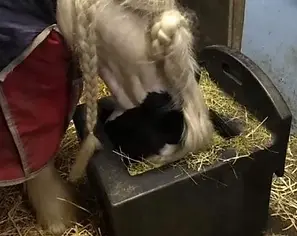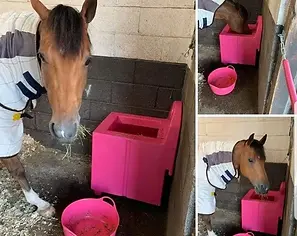HEALTH BENEFITS

RESPIRATORY BENEFITS
Feeding at ground level allows the respiratory system to work naturally and most effectively as there is decreased exposure to respiratory irritants.
More importantly, a lowered head and neck position encourages natural airway drainage; this is the first line of defence against deep inhalation of food and prevents dust related particles hitting the walls of the airways and imbedding in the mucous membrane which can lead to chest and lung infection and respiratory complaints such a COPD.
Left dry, millions of tiny dust particles are consumed by horses in their hay on a daily basis. Soaking hay is a simple but very effective way of removing dust particles and other unwanted spores that are crucial to the good management of conditions such as COPD and HYPP.


WEIGHT MANAGEMENT
The necessity for soaking hay is becoming ever more increasingly common with modern day horse keeping. More horses are now being barn / stabled kept and the quality of hay is often unreliable and inconsistent meaning that intake levels of carbohydrates and potassium are hard to monitor.
The reduction of potassium and carbohydrates by soaking are essential in the management of laminitis, metabolic and dietary conditions where intake levels must be closely monitored.
In order to make an informed decision about what you are feeding your equine, Nicola Tyler BSc (Hons), Nutrition Director of Topspec & Anna Welch BVSc, MRCVS advise that hay is sent for analysis. Whilst waiting for the results, in order to be pro-active they advise that hay is soaked in plenty of cold or lukewarm water for 3-12 hours as this allows a significant percentage of the sugars it contains to leach out in to the water.
(There is however a lot of speculation & varying scientific research about the length of time hay should be soaked for so it is advised you get this information directly from your vet, specifically for your horse.)

POSTURAL BENEFITS
Feeding in a ‘natural’ downward position ensures there is very minimal tension through the neck and back; therefore working as a natural stretch of the horses top line, keeping the joints and muscles supple and minimising strain.
When feeding from a hay net or high wall mounted hay rack, the horse has to use their neck and back muscles in an incorrect posture, causing unnecessary strain and potential injury.
A combination of correct training and good feeding routine will go a long way to improving and maintaining good equine posture and suppleness.


BEHAVIOURAL BENEFITS
Feeding from ground level is most the natural, relaxed and protective way for a horse to feed.
Floor feeding allows the horse a vision range of virtually 360 degrees - being a flight animal it is important that the horse has the ability to have this span of view whilst eating to ensure complete relaxation.
Horses are often fed from nets at height to 'slow them down', however research has shown that this is not actually the case for the majority of equines.
The annoyance of not being able to easily obtain the hay in fact speeds up the rate at which hay is pulled at and consumed - the horse may even become aggressive towards the food as he is 'panic eating'.


NUTRITION
"Despite its ability to graze for long periods, a horse has a limited appetite and can only consume the equivalent of 2 - 2.5% of its bodyweight as food per day. Ideally, as much of this as possible should be forage and a horse should never be fed less forage than the equivalent of 1% of its bodyweight (5kg/10lb for a 500kg horse).
Apart from its nutritional contribution to the horse, forage is also of physiological and psychological importance to the horse. The digestive system is designed to have a constant steady flow of fibre-rich food flowing through so access to ad lib forage will ensure it continues to function healthily. The horse is designed to graze for 18 out of every 24 hours and being deprived of forage or pasture for any length of time will cause stress as well as digestive upset. Also chewing releases saliva, which helps neutralise the acid constantly produced by the horse’s stomach, so any period without forage leaves the stomach vulnerable to ulceration."
Baileys Horse Feeds

DIGESTION BENEFITS
Encouraging a slower rate of consumption leads to more thoroughly chewed food which is then mixed well with saliva, in turn optimising the rate of digestion.
This increased rate of digestion decreases the chance of impaction colic and other digestive related illnesses.
Many modern day stabled & competition horses suffer from stomach ulcers due to a varying number of factors - stress, travel, poor nutrition, workload - so good feed management and forage availability is a key factor in reducing the risk of ulcers developing.
The incorporation of a return lip around the top of the Haycube means that large sections of hay are not easily attainable by the horse, therefore slowing down the rate of consumption, however still encouraging relaxed, ground level feeding.


SOAKING HAY
"Soaking hay is an invaluable measure for the prevention and good management of all equines, particularly those pre-disposed to metabolic conditions such as EMS, Cushings & laminitis. The removal of carbohydrates through soaking is paramount and should be considered by more equine owners as prevention rather than cure."
Tim Selby Dip WCF
Farrier

GROUND LEVEL
"By eating off of the ground, the horse is able to naturally release the jaw downward and relax it; and by eating lots of roughage, he is better able to wear down his teeth evenly by chewing in long strokes from side to side. Horses not allowed to eat from ground level, and not allowed adequate grazing or time to nibble hay at liberty may develop issues with uneven wear and joint misalignment."
Dr. Roger Cole DVM
Equine Dentist

STABLE POSTURE
"Horses in a natural environment spend many hours grazing in a downward ground level position – therefore, it is important that this position is replicated within an artificial stabled environment in order to most benefit our horses posture and well-being."
Beverley Berns ACPAT
Chartered Physiotherapist

"One by one all of our liveries have moved across from haynets to Haycubes! The horses are happy, healthy & definite Haycube converts!!"
Sam, Elms Farm Livery
"Such a brilliant idea!! The Haycube really is so easy to use & has made soaking on my yard so easy – Thank You!"
Julie, Valley Equestrian
"Our staff love the Haycube! They are busy caring for sick horses & ponies so anything that allows them more time to spend with the animals is a fantastic asset to the practice - The Haycube certainly does that & more."
Three Counties Equine Vets
